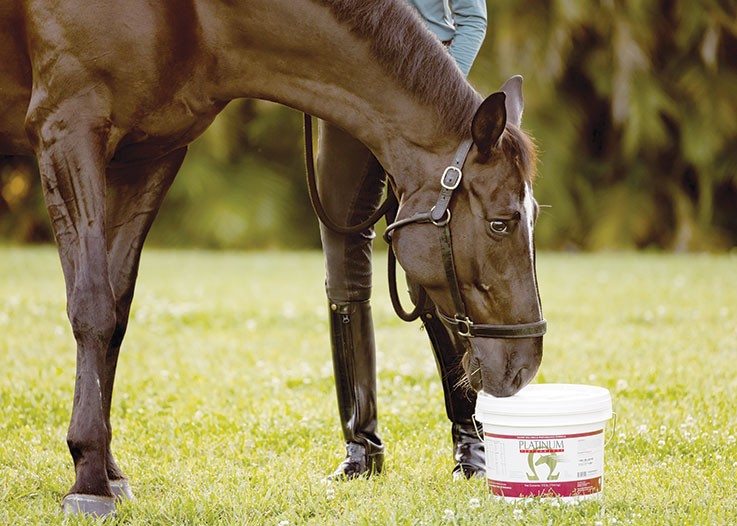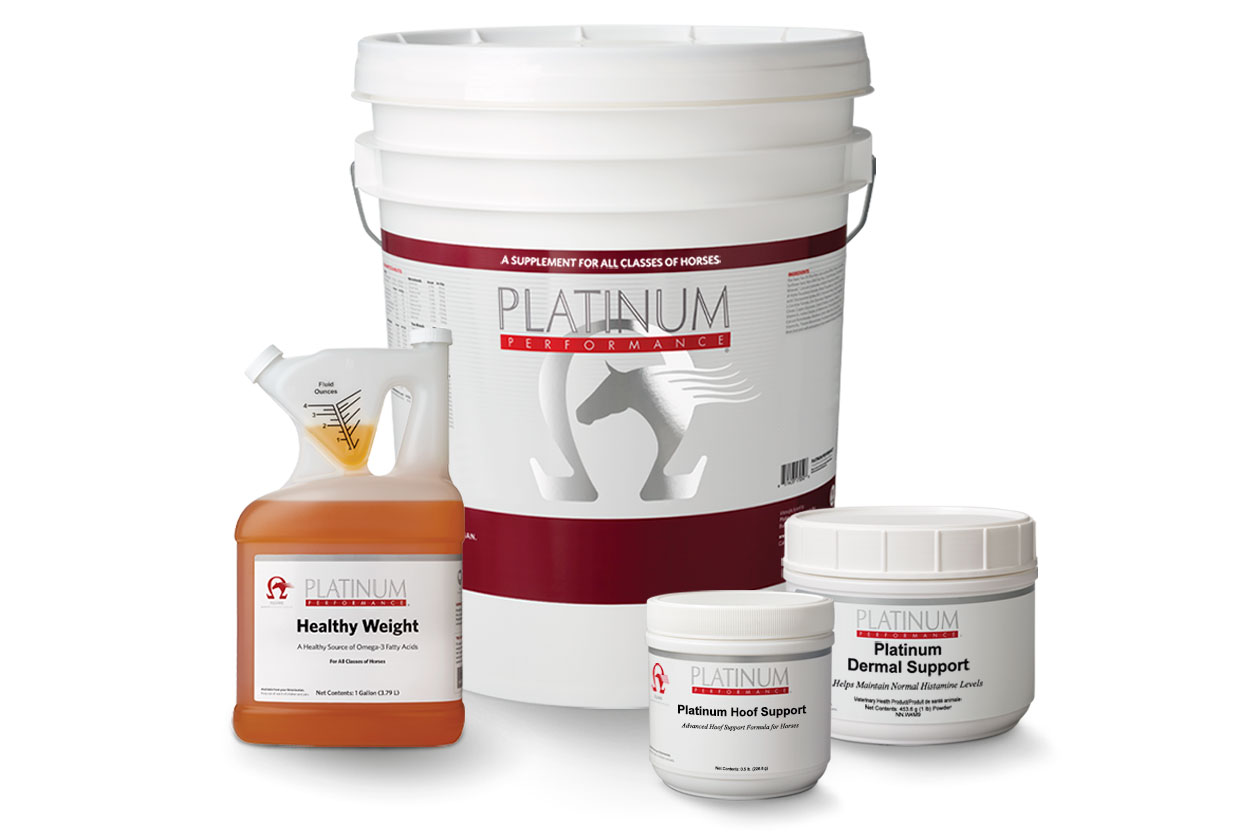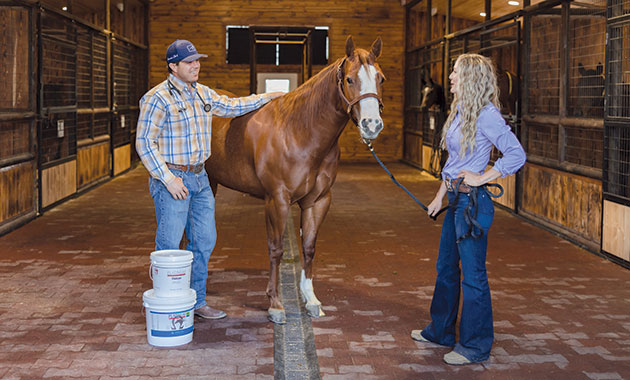Nutrition, Grooming Habits, Environment and Overall Horse Health Contribute
Horse owners and caretakers take great pride in maintaining a horse’s healthy, shiny coat, along with its beautiful mane and tail. The effort goes beyond aesthetics; the horse’s exterior is also seen as a reflection of its overall health and well-being. Regular grooming is part of preserving a lustrous coat, but true brilliance requires more. So, what’s the secret to making your horse shine like a diamond under the sun?
Achieving and maintaining that lustrous coat is a journey requiring patience, consistency and basic know-how.
Understanding Your Horse’s Skin and Hair
The skin and coat are more than just superficial features; they serve as a protective barrier against environmental elements and play a key role in temperature regulation. Each component of the skin and coat has a specific and important function.
Skin Deep
The skin is the largest organ of a horse’s body, performing numerous vital functions. It is made up of three main layers: the epidermis (outer layer); dermis (middle layer); and hypodermis (subcutaneous layer or inside layer).
The epidermis is a protective barrier against dirt, bacteria and ultraviolet rays. Composed mainly of keratinocytes, which produce keratin protein that adds strength and resilience to the skin. It also contains dead, keratinized cells that form a protective outer layer and melanocytes, cells that produce melanin — the pigment responsible for skin and hair color. Darker-skinned areas contain more melanin, while lighter areas have less.
The dermis lies beneath the epidermis and provides strength, flexibility and elasticity to the skin due to its collagen and elastin fibers. It contains blood vessels, nerves, hair follicles, sweat glands (for temperature regulation) and sebaceous glands, which secrete sebum (an oily substance) to keep the skin and each hair follicle lubricated.
The hypodermis is the deepest layer of the skin, beneath the dermis and above the skeletal muscles. Also known as the subcutaneous tissue, it is primarily made up of fat cells and connective tissue. It provides insulation, helping regulate the horse’s body temperature and cushioning to protect underlying muscles and bones.
Millions of Hairs
A horse’s coat comprises millions of hairs, made mostly of keratin, a fibrous protein that is strong, flexible and resistant to damage. It also contains lipids, minerals, water and pigments. (A horse’s hoof is essentially a modified form of hair, composed of the same materials. As a result, both hair and hoof benefit from similar nutritional support.) Each hair has a hair shaft that consists of three layers: the central canal, called the medulla; the cortex; and cuticle, the outermost layer. These layers support many functions, such as protecting hair from damage, housing pigment and providing strength and flexibility. Hair grows from follicles in the dermis. Each follicle contains cells that actively divide to form the hair shaft and send it upward through the skin. Hair growth occurs in cycles, consisting of a growth, rest and shedding phase. Each follicle follows its own growth cycle, so hair is constantly shedding and growing back.

©2025 PLATINUM PERFORMANCE, INC./TOPLINE DESIGN
Skin: The Largest Organ of a Horse’s Body
The skin and coat serve as a protective barrier and play a key role in temperature regulation. The skin is made up of three main layers: the epidermis (outer layer); dermis (middle layer); and hypodermis (subcutaneous layer or inside layer).
Steps to Achieving a Glossy Coat
Achieving a glistening coat and healthy skin for your horse requires attention to several key factors. By addressing these, you can help your horse truly shine, inside and out.
1. Nourish for Radiance
Proper nutrition is the cornerstone. Hair follicles rely on the nutrients delivered through the bloodstream. Skin and coat health rank lower in nutrient priority to a horse’s vital organs — the heart, liver and kidneys — meaning that the skin and coat often reflect the horse’s nutritional resources revealing dietary deficiencies.
A balanced diet that meets all nutritional needs will enhance coat appearance, improve skin health and help combat other health issues. Establishing a balanced diet starts with a forage- first approach, minimizing the use of concentrates. Quality forage should form the bulk of the diet, containing essential fibers that support good gut health and function, while being a source of energy, vitamins, minerals, amino acids and fatty acids. However, forage alone may not meet all nutrient needs, and additional supplementation to fill in any dietary gaps is often necessary.

Hair follicles rely on the nutrients delivered through the bloodstream. Skin and coat health rank lower in nutrient priority to a horse’s vital organs, meaning that the skin and coat often reflect the horse’s nutritional resources revealing dietary deficiencies.

Several key nutrients promote healthy hair growth, texture and shine, while also preventing skin dryness and irritation.
Several key nutrients promote healthy hair growth, texture and shine, while also preventing skin dryness and irritation.
-
Amino Acids
Hair is largely made of keratin, a crucial structural protein that needs continual replenishment. Inadequate quality protein intake can lead to poor coat condition, slow hair growth and even hair loss. The quality of a protein is determined by the building blocks of amino acids it contains. The higher the quantity of specific important or essential amino acids, such as lysine, methionine and threonine, the higher quality that protein is. Lysine, methionine, cysteine and arginine are amino acids important for hair structure, growth and repair. Essential amino acids, methionine and lysine are needed to produce all proteins in the body, including keratin. They are also needed for collagen formation, which supports skin structure. Cystine, a non-essential amino acid (the body can produce it), plays a role in keratin formation and helps prevent hair from becoming brittle. The amino acid arginine is important in nitric oxide production, which helps improve blood flow throughout the body, helping deliver nutrients to the skin and hair follicles. A high-quality protein source, such as alfalfa, can be added to enhance your horse’s protein profile in its forage, as well as a supplement containing a full profile of amino acids, can all be a part of supporting a high-quality protein diet for hair and skin vitality.
-
Fatty Acids
Omega-3 and omega-6 essential fatty acids are necessary for maintaining and improving skin elasticity, moisture retention and a shiny coat. They support the production of skin oils from the sebaceous gland, helping create a moisture barrier for skin cells and hair shafts. Omega-3 and omega-6 fatty acids must come from the diet, as the body cannot produce them, and they need to be maintained in the proper balance. A higher omega-3-to-omega-6 ratio is recommended, as omega-3s — found in flaxseed oil, fish oil and grasses — support non-inflammatory pathways, while omega-6s — found in grains and vegetable oils like sunflower, canola or corn — can promote inflammation. A constant level of inflammation can lead to or worsen skin issues. Horses rarely lack for omega-6s in their diet. Omega-3s, on the other hand, break down quickly in forages, leading to a relative deficiency. Adding a small amount of flaxseed oil, such as 1/8 cup, can help improve coat quality by adding more omega-3s to the diet without adding a significant number of calories.
-
Vitamins and Minerals
Several vitamins and minerals help improve skin and coat appearance and vitality. Vitamins E, A and C are antioxidants that protect against oxidative stress, an imbalance of the free radical-to-antioxidant ratio in the body that can cause cell damage, impairing skin and coat appearance and function.
Vitamin E, paired with the mineral selenium, act as a dynamic antioxidant duo — selenium protects the cell interior, while vitamin E shields the exterior — supporting healthy hair follicles and skin cells. Too much selenium, however, is known to replace the sulfur in amino acids found in keratin, leading to a serious condition called Alkali disease, which will cause hair, mane and tail loss and other health and hoof issues. It is important to know your horse’s selenium status and avoid over-supplementation.
Vitamin C can be produced naturally in the horse’s body by microbes in the GI tract, but age, stress and a weakened immune system can increase a horse’s need for this antioxidant. It supports collagen production, a protein needed to maintain skin and hair follicle cell integrity and structure.
Vitamin A supports the health of epithelial cells on the skin by being an antioxidant source but also by assisting in cell turnover. It also helps regulate the production of sebum for skin and hair hydration and sheen, which can also have a positive impact on the shedding process and the growth of new hair
The B vitamins have a role in making proteins in the horse’s body, such as collagen. Biotin, also known as vitamin B7, is particularly important for hair health. It enhances strength and growth by supporting the function of keratin in hair follicles. Bacteria in a horse’s gut can synthesize B vitamins, which is one reason why a healthy gut environment is important and central to a horse’s outer appearance.
Copper and zinc work closely together and are necessary for keratin production. These minerals play a role in epithelial cell turnover, collagen integrity and aid in the production of melanin. Copper, in particular, is involved in the tyrosinase enzyme that regulates melanin production. Iron helps in the formation of red blood cells and ensures proper oxygenation of tissues, including the skin and hair follicles. A proper balance between iron, copper and zinc is integral to a healthy coat. When the ratios of these minerals are off in the diet, absorption of one can be limited by the abundance of another, leading to a deficiency.
-
Water
Water, which makes up roughly 70% of an adult horse’s body weight, is an important component for skin and hair health. Though not a nutrient, proper hydration helps maintain skin moisture, preventing dryness, flakiness and irritation. Dehydration can cause brittle hair and flaky skin, so access to clean, fresh water is essential, especially during hot weather or after exercise when a horse loses fluids through sweat.

Regular grooming is not just a cosmetic practice for horses, it stimulates blood flow and promotes healthier hair growth and skin renewal. It also removes dirt and debris that can cause skin irritations or infections and helps distribute natural oils produced by the sebaceous glands.
Regular grooming is not just a cosmetic practice for horses, it stimulates blood flow and promotes healthier hair growth and skin renewal. It also removes dirt and debris that can cause skin irritations or infections and helps distribute natural oils produced by the sebaceous glands.
2. Groom for Gloss
Regular grooming is not just a cosmetic practice for horses, it stimulates blood flow and promotes healthier hair growth and skin renewal. It also removes dirt and debris that can cause skin irritations or infections and helps distribute natural oils produced by the sebaceous glands. These oils lubricate the coat, keeping it shiny and protecting the skin underneath.
Bathing a horse is a common practice, and while the occasional bath helps remove sweat, dirt and bacteria, it’s important not to overdo it. Excessive shampooing can strip the skin of its natural oils, leading to dryness, irritation and a lackluster coat. Incorporating periodic baths, using gentle, horse-specific shampoos is a best practice. So, get out the currycomb and enjoy some bonding time with your horse.
3. Guard Against Parasites
External parasites — flies, ticks, mites and lice — are not only irritating but can cause skin infections, hair loss and general discomfort brought on by constant itching and scratching. Scratches and parasite bites can create openings in the skin, leaving the horse vulnerable to secondary infections, including bacterial and fungal. Internal parasites can impede nutrient absorption, resulting in poor coat quality and even hair loss. Keeping your horse free from both internal and external parasites will help ensure a shiny, healthy coat. Regular parasite control methods, such as deworming, topical treatments and fly-management strategies should be implemented.
Platinum Products That Support a Healthy Coat

Platinum Performance® Equine: A comprehensive blend of omega-3 fatty acids, amino acids, vitamins, minerals, antioxidants and digestive-supporting ingredients can be a part of a balanced diet.
Healthy Weight: A flaxseed oil infused with vitamin E provides a rich source of omega-3 fatty acids.
Platinum Hoof Support: A source of essential amino acids lysine and methionine, as well as biotin (vitamin B7), zinc and copper.
Platinum Dermal Support: Supports normal histamine levels due to a seasonal allergic response.
4. Create a Happy Space
A horse’s environment can significantly impact skin and coat condition. Care needs will change depending on the climate. When the weather is hot, horses are at risk of sunburn, dehydration and heat stress, all of which affect skin and coat. Providing shade, plenty of fresh water and access to cool, dry areas helps prevent these issues. Some horses may require sunscreen or a UV-protective fly sheet to shield them from harmful rays. Factoring into this are unique breed-specific coat and skin requirements. For example, breeds with fine coats, like Thoroughbreds, or those with pale skin, like Paints, are more susceptible to sunburn. Shires or Clydesdales, with their heavy feathering and large size, may need extra care to prevent skin issues like dermatitis and scratches. During winter months, horses grow thicker coats, and exposure to cold, wet conditions can lead to rain rot and fungal infections. Providing proper shelter to keep horses dry and warm during colder months is essential for skin protection. Blankets can keep a horse warm, but don’t be too quick to cover a healthy horse with its thick, winter coat. Hair follicles can pull hair upright to provide an insulating effect, and blankets that flatten the haircoat can reduce this ability. Over-blanketing also causes overheating and sweating associated with chills and other skin issues.
5. Monitor Health
Coat and skin issues are sometimes a result of underlying health conditions. Allergies — to provided feed, forage or environmental factors — can cause skin irritation, hives and hair loss. Skin infection, both bacterial or fungal, such as rain rot or ringworm, can result in hair loss, scabbing and discomfort. Horses with endocrine disorders like Cushing’s disease or hypothyroidism often experience changes in their coat. A horse with Cushing’s commonly hangs onto its shaggy coat long after the winter months. Hormonal fluctuations can also affect coat quality, causing dullness, hair loss or uneven shedding. Poor digestive health can hinder nutrient absorption and weaken the immune system, leading to a lackluster coat and irritated skin. If your horse shows signs of abnormal coat or skin issues, consult a veterinarian to rule out serious health problems. Regular checkups can help catch potential health concerns early, ensuring your horse maintains a healthy, radiant coat.
Coat Color and Sun Bleaching

Horses with darker coats, such as bay and black horses, are more prone to sun bleaching, a phenomenon in which their coat lightens from prolonged sun exposure.
Horses with darker coats, such as bay and black horses, are more prone to sun bleaching, a phenomenon in which their coat lightens from prolonged sun exposure.
Horses have a variety of coat colors, and these colors can be affected by various factors, including genetics, diet and environmental influences.
Horses with darker coats, such as bay and black horses, are more prone to sun bleaching, a phenomenon in which their coat lightens from prolonged sun exposure. The darker a horse’s coat, the more melanin pigment is present, which is what gives coat its color. Ultraviolet (UV) rays break down melanin, causing a lighter, faded coat appearance. Sun bleaching effects are more obvious in the mane, tail and flank, where the sun hits the hardest. Sweat can further exacerbate bleaching as salt left on the coat for extended periods can cause the coat to become dry and dull.
Genetics and environmental factors play a bigger role in coat color and sun bleaching than diet, but copper and zinc levels do influence the depth and intensity of coat color. A deficiency in these trace minerals can impact melanin synthesis, resulting in lighter coat colors or a duller appearance.
While sun bleaching doesn’t affect a horse’s health, some owners may want to minimize its effects for aesthetic reasons or to maintain their horse’s original color for shows.
How to manage and prevent excessive sun bleaching:
Shade and UV Protection
Provide access to shade during peak sun hours to reduce sunlight exposure. Use UV-protective fly sheets, masks or blankets made from fabrics designed to shield the horse’s coat from the sun.
Grooming
Regular grooming helps distribute natural oils in the coat to help maintain condition and improve natural resilience against sun damage. Brushing can also remove dirt and debris. Left unchecked these form darker areas on the coat that can absorb more UV rays than lighter-colored hair. Regular rinsing or wiping down areas where sweat has accumulated can be beneficial.
A Balanced Diet
Providing a balanced diet aids in preventative efforts to maintain coat color. Avoid single ingredient additions, such as copper, since it is easy to throw other trace minerals out of balance. It’s important to keep a balanced ratio of certain minerals, such as copper, zinc and iron, to ensure better absorption in the body
Fun Fact: Daylight Length and Hair Growth in Horses
The length of daylight actually influences your horse’s hair growth. As days get longer in the spring, horses naturally begin to shed winter coats and grow in a lighter, shorter coat but not because the weather is warming. This process is controlled by the horse’s internal clock, which responds to changes in daylight hours. Increased daylight triggers the pineal gland response in the brain to start shedding that thick coat in favor of a thinner summer coat. Daylight is shorter in winter when the opposite occurs, and the cycle triggers a thicker winter coat to help a horse stay warm.
Light therapy is sometimes used to help regulate the shedding process. Artificial lights can extend daylight hours during winter to encourage earlier shedding. So, the longer the daylight, the faster a horse can say goodbye to that cozy winter coat and hello to its sleek, summer show-ready shine.

By focusing on their nutrition, environment and overall well-being, you’re not just enhancing their appearance but supporting their health at a deeper level.
By focusing on their nutrition, environment and overall well-being, you’re not just enhancing their appearance but supporting their health at a deeper level.
The Final Polish
Achieving and maintaining that lustrous coat is a journey requiring patience, consistency and basic know-how. It’s not just about the products you use or grooming frequency; it’s about nurturing your horse from the inside out. By focusing on their nutrition, environment and overall well-being, you’re not just enhancing their appearance but supporting their health at a deeper level. So, keep investing in your horse’s health, stay attentive to their needs and don’t forget to enjoy the bond gained through those grooming sessions. The gleam in their coat will be a testament to the love and care you give them every day because every horse deserves to sparkle.

